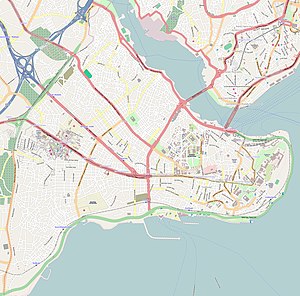Imperial Arsenal
| Imperial Arsenal | |
|---|---|
Tersâne-i Âmire | |
Pera, 1836 | |
| Coordinates | 41°02′01″N 28°57′27″E / 41.03361°N 28.95750°E |
| Type | Naval base and shipyard |
| Site information | |
| Owner | Ottoman Navy |
| Site history | |
| Built | 1454 |
| Fate | Replaced by the civilian Haliç Tersaneleri |
The Imperial Arsenal (
Etymology
| Military of the Ottoman Empire |
|---|
 |
The Ottoman Turks used the word liman (from Greek limēn) to refer to harbours in general, but in the 15th century they also adopted and increasingly began to use the term tersane (often misinterpreted as tershane, incorporating the term hane, "house") from Italian darsena, "shipyard"—likewise the origin of the English "
History
In the course of their
After the
In 1546–49, Sokollu Mehmed Pasha built a small stone storehouse, with a flat, lead-covered roof, behind each dock, for the storing of the ship's gear and shipbuilding materials.[1][3] He also walled off the arsenal grounds from their landward side to conceal its activity from prying eyes.[1][3] In addition, during this period the arsenal contained a storehouse for oars, the "store of the seventy captains" housing equipment for 70 ships and seven other storehouses, the offices (divanhane) of the Kapudan Pasha (the fleet's chief admiral), the powder magazine tower, the Sanbola dungeon, the Cirid Meydan pavilion, the gates of Şahkulu and the Meyyit harbour.[1] By 1557, the arsenal counted 123 docks.[3] Following the destruction of the Ottoman fleet in the Battle of Lepanto (1571), the Imperial Arsenal was extensively renovated, with eight new dockyards built inland, surrounding the royal garden (has bahçe).[1] By the end of the 16th century, two large storehouses had been built: the Kurşunlu storehouse, for shipbuilding and rigging materials and other ship equipment, and a storehouse for timber.[1]
By the mid-17th century, the number of docks had risen to 140.[1] At its peak in the 16th and 17th centuries, the Imperial Arsenal was a major industrial concern, "with dry docks, shipyards, storehouses, a spinning mill for making cordage, and iron foundries (for making anchors), supplemented by public buildings, including a mosque, fountains, a hospital, and a prison, all clustered in the Golden Horn".[1] Nevertheless, the 17th century saw decline: in 1601 the shipyard had 3524 employees but this number steadily fell, reaching 726 in 1700. During this period an increasing amount of work was done by other shipyards.[2] This was facilitated by the fact that galleys, which formed the bulk of the Ottoman navy until the late 17th century, could be built by any skilled shipwright, and that consequently they were frequently built in the provinces at coastal or river sites, and only brought to the Imperial Arsenal for outfitting.[3]

With the introduction of
In 1838, under the auspices of the American Foster Rhodes, the Imperial Arsenal produced its first steamship.
The facilities are still in use today and go by the common name "Haliç Shipyards". Camialtı Shipyard, Taşkızak Shipyard and The Haliç Shipyard are three distinct facilities. Only Haliç Shipyard is now in operation out of these three shipyards. Haliç Shipyard is the oldest shipyard in continuous operation in the world.
Administration
The Imperial Arsenal was under the direct supervision of the Kapudan Pasha, and its administration was headed by three officials: the
In the Age of Sail (late 17th–mid-19th centuries), each ship's superintendent, treasurer and scribe were also considered as part of the officer corps, while "captains, mariners, overseers, messengers, shipwrights, caulkers, oar makers, ironsmiths, repairmen, spoolers, towmen, grenade-makers, guards, and retired personnel" comprised the numerous "common folk" of the Arsenal.[1]
As part of Selim III's military reforms, the tersane emini was replaced in 1804 by the Ministry of Naval Affairs (Umur-ı Bahriye Nezareti), while a modern financial department and treasury were created for the Arsenal in the next year.[1] In 1845, the separate Ministry of the Imperial Arsenal (Tersane-i Amire Nezareti) was created.[1]
See also
References
Sources
- Bostan, İdris (2015). "Imperial Arsenal". In Fleet, Kate; Krämer, Gudrun; Matringe, Denis; Nawas, John; Rowson, Everett (eds.). Encyclopaedia of Islam, 3rd Edition. Brill Online. Retrieved 25 February 2015.
- Imber, Colin (2000). "Tersâne". In ISBN 978-90-04-11211-7.
- Langensiepen, Bernd; Güleryüz, Ahmet (1995). The Ottoman Steam Navy, 1828–1923. Conway Maritime Press. ISBN 0-85177-610-8.
Further reading
- Müller-Wiener, W. (1987). "Zur Geschichte des Tersâne-i Âmire in İstanbul". In Jean-Louis Bacqué-Grammont; et al. (eds.). Turkische Miszelle: Robert Anhegger Festschrift, Armağanı, Melanges (in German). Istanbul: Editions Divit. pp. 253–273.

